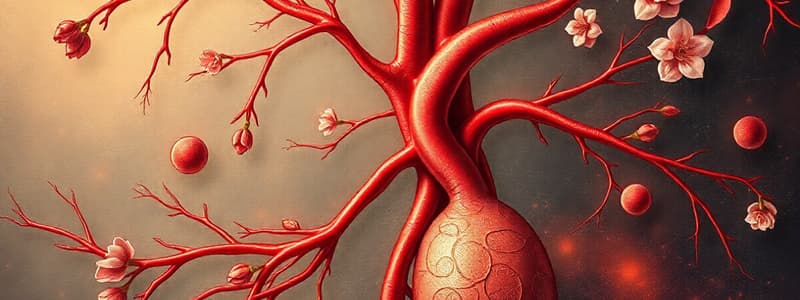Podcast
Questions and Answers
What is the main function of the cardiovascular system?
What is the main function of the cardiovascular system?
- To oxygenate blood in the lungs
- To collect excess tissue fluid
- To exchange substances between blood and tissues
- To transport blood between the heart and tissues (correct)
Which component of the circulation carries oxygenated blood to the body?
Which component of the circulation carries oxygenated blood to the body?
- Systemic circuit (correct)
- Pulmonary circuit
- Coronary circuit
- Lymphatic system
Which type of blood vessel carries blood from the tissues back to the heart?
Which type of blood vessel carries blood from the tissues back to the heart?
- Aorta
- Veins (correct)
- Arteries
- Capillaries
What structure separates oxygenated and non-oxygenated blood in the heart?
What structure separates oxygenated and non-oxygenated blood in the heart?
Which layer of the heart wall is the thickest?
Which layer of the heart wall is the thickest?
What type of blood vessel is primarily involved in the exchange of substances?
What type of blood vessel is primarily involved in the exchange of substances?
Which statement about the lymphatic system is true?
Which statement about the lymphatic system is true?
What substance primarily makes up the wall of the myocardium?
What substance primarily makes up the wall of the myocardium?
What is the primary function of the tunica intima in blood vessels?
What is the primary function of the tunica intima in blood vessels?
How do veins differ from arteries in terms of their tunica media?
How do veins differ from arteries in terms of their tunica media?
Which type of capillary is characterized by the presence of pores in its walls?
Which type of capillary is characterized by the presence of pores in its walls?
What role does the lymphatic system play in the body?
What role does the lymphatic system play in the body?
Which characteristic is NOT associated with sinusoids?
Which characteristic is NOT associated with sinusoids?
What is primarily contained in lymphatic nodes?
What is primarily contained in lymphatic nodes?
Which layer of an artery is primarily responsible for the elasticity of the vessel?
Which layer of an artery is primarily responsible for the elasticity of the vessel?
What distinguishes the structure of lymphatic vessels from that of blood capillaries?
What distinguishes the structure of lymphatic vessels from that of blood capillaries?
Flashcards
Arteries
Arteries
A type of blood vessel that carries blood away from the heart at high pressure.
Tunica intima
Tunica intima
The innermost layer of an artery, composed of endothelium and connective tissue.
Tunica media
Tunica media
The thickest layer of an artery, made of smooth muscle and elastic fibers.
Tunica adventitia
Tunica adventitia
Signup and view all the flashcards
Veins
Veins
Signup and view all the flashcards
Capillaries
Capillaries
Signup and view all the flashcards
Lymphatic system
Lymphatic system
Signup and view all the flashcards
Lymphatic nodes
Lymphatic nodes
Signup and view all the flashcards
Circulatory System
Circulatory System
Signup and view all the flashcards
Cardiovascular system
Cardiovascular system
Signup and view all the flashcards
Pulmonary Circuit
Pulmonary Circuit
Signup and view all the flashcards
Systemic Circuit
Systemic Circuit
Signup and view all the flashcards
Study Notes
Circulatory System
- Consists of two main components: cardiovascular and lymphatic systems
- Cardiovascular system transports blood between heart and tissues, in both directions
- Lymphatic system collects lymph (excess tissue fluid) and returns it to the cardiovascular system
Cardiovascular System
- Composed of blood vessels (carry blood) and heart (pumps blood)
- Two circulatory circuits:
- Pulmonary circuit: carries blood from the heart to the lungs for oxygenation and back to the heart
- Systemic circuit: carries oxygenated blood from the heart to the body and returns deoxygenated blood to the heart
- Three types of vessels:
- Arteries: carry blood from the heart to the tissues
- Veins: carry blood from the tissues to the heart
- Capillaries: thin-walled vessels for substance exchange between blood and tissues (where arteries end and veins start)
Heart
- Organ responsible for pumping blood to both pulmonary and systemic circuits
- Four chambers: two atria (receive blood) and two ventricles (pump blood)
- Keeps oxygenated and deoxygenated blood separate in different sides of the heart
- Different valves (mitral, tricuspid, aortic, pulmonary valves) ensure one-way blood flow
Heart Wall
- Three layers:
- Endocardium: Innermost layer, simple squamous epithelium (endothelium) and fibroelastic layer
- Myocardium: Thicker middle layer, cardiac striated muscle
- Epicardium: Outermost layer, connective tissue and simple squamous epithelium
Arteries
- Carry blood from the heart to capillaries at high pressure
- Three layers:
- Tunica intima: Innermost layer, endothelium and loose connective tissue, internal elastic lamina
- Tunica media: Thickest layer, smooth muscle and elastic fibers, external elastic lamina in large arteries
- Tunica adventitia: Outermost layer, dense irregular connective tissue
Veins
- Carry blood from capillaries to the heart, lower pressure than arteries
- Similar layers to arteries, but tunica media is thinner and lacks elastic fibers
Capillaries
- Smallest blood vessels, only endothelium
- Three types:
- Continuous: found in muscle, nervous tissue, lungs and exocrine glands. Tight junctions between cells
- Fenestrated: have pores in their walls (pancreas, intestines, kidneys, and endocrine glands)
- Sinusoids: large diameter, numerous perforations, irregular channels (bone marrow, liver, spleen, lymphoid and endocrine glands)
Lymphatic System
- Collects excess tissue fluid (lymph), returns it to the circulatory system
- Open system, no pump
- Lymphatic vessels: similar structure to veins, but more permeable than blood vessels
- Lymph nodes: small, rounded organs that filter lymph and contain lymphocytes and other immune cells.
- Other organs include thymus, bone marrow, and spleen
Lymph
- Excess interstitial fluid circulating through the lymphatic system
- Functions:
- Transports white blood cells (lymphocytes, macrophages, dendritic cells)
- Removes waste and toxins from tissues
- Maintains fluid balance
Studying That Suits You
Use AI to generate personalized quizzes and flashcards to suit your learning preferences.




